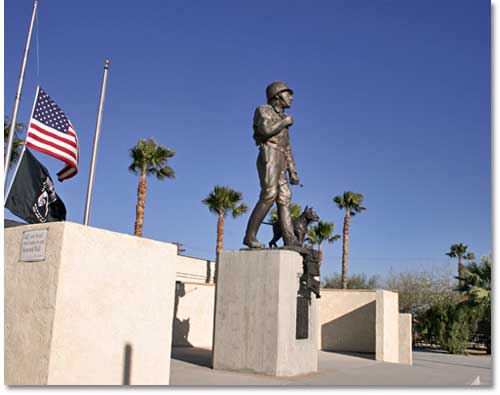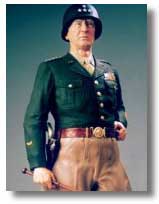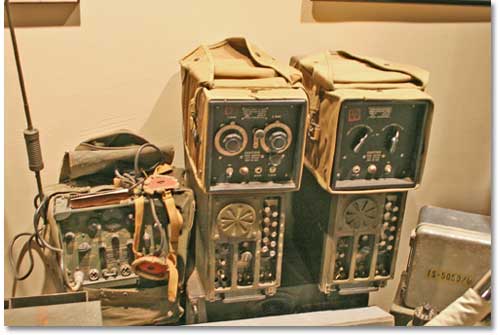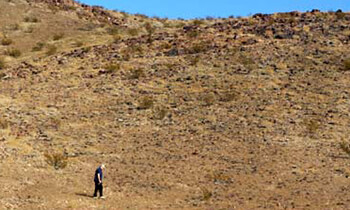George S. Patton Memorial Museum
Chiriaco Summit, CA - on I-10, 30 Miles East of Indio

The General George S. Patton Memorial Museum was established
to honor the late General George S. Patton and the thousands of men who served
with him at the Desert Training Center (DTC) and overseas.
The museum is located off
Interstate 10, about 30 miles east of  Indio at Chiriaco Summit, which was the
entrance to Camp Young, command post for the DTC during World War II. The site
was donated by Joseph Chiriaco, one of the first area residents General Patton
met when he arrived to set up the center.
Indio at Chiriaco Summit, which was the
entrance to Camp Young, command post for the DTC during World War II. The site
was donated by Joseph Chiriaco, one of the first area residents General Patton
met when he arrived to set up the center.
Exhibits display memorabilia from the life and career of General Patton. The exhibit halls include the many and varied aspects of military life with particular focus on the Desert Training Center and the soldiers of World War II. Information concerning Southern California water development and the building of the Colorado Aqueduct can be found as well as natural science exhibits, which show rocks, minerals and fossils of the region and plants and animal life of the desert and mountains.
History
In January 1942, just a month after the United States entered the war, German troops under the command of Field Marshall Rommel started pushing toward Egypt, threatening the Suez Canal. The British experienced great difficulty fighting an enemy well versed and able in the use of tanks as a tactical weapon in the desert. It was evident that U.S. troops would have to engage in a desert campaign. There was no background for such an engagement in the history of U.S. warfare.

On February 5, 1942, Lt. General Lesley J. McNair, Chief of Staff, General Headquarters, gave his approval to a plan developed to stop Germany's advance in Northern Africa. He designated Major General George S. Patton, Jr. to establish the Desert Training Center for the purpose of training men and machines for action under the harsh conditions of the African deserts.
 With staff officers, he flew over a vast expanse of sand and brush weeds in Southern California and portions of Arizona and Nevada. Later, he covered much of the area on foot and on horseback. He decided this was the place to build a force for desert combat. The area selected by General Patton in the California and Arizona deserts encompassed approximately 18,000 square miles, making it the largest military installation and maneuver area in the world.
With staff officers, he flew over a vast expanse of sand and brush weeds in Southern California and portions of Arizona and Nevada. Later, he covered much of the area on foot and on horseback. He decided this was the place to build a force for desert combat. The area selected by General Patton in the California and Arizona deserts encompassed approximately 18,000 square miles, making it the largest military installation and maneuver area in the world.
Patton described the area chosen as: "...the best I have ever seen ... it is desolate and remote ... large enough for any kind of training exercises."
The first troops to arrive at the Desert Training Center described it as "the place God forgot." It was eventually to become the training ground for more than a million troops in seven armored divisions and thirteen infantry divisions.
General Patton arrived, and the DTC became operational in early April 1942. Four days later, he and the troops took their first desert march. Within 15 days, all units at the center had been on a desert march. Within 23 days, he had conducted 13 tactical exercises, including some with two nights in the desert.

Detail of map produced by 671st Engr. Co of Desert Training Center locations.
Click here
to see the whole map (pdf)
Click here to
see a map with a more general overview (pdf)
Source: BLM
Patton was determined to move fast and to prepare his men well. Conditions were primitive. Some had wooden floors for their tents, but none had electricity, or sheets for their cots, and none of the amenities common to other stateside military installations were present.

When the Metropolitan Water District in Los Angeles suggested that the men build storage tanks for water, the General declined, saying, 'They have no time to do anything except learn to fight." Within a month after arrival, every man sent to the Desert Training Center had to be able to run a mile in 10 minutes, wearing a full back pack and carrying a rifle.

When General Patton started operating the Desert Training Center, he knew little about the desert. He called upon the expertise of Roy Chapman Andrews, an explorer who had made several expeditions to the Gobi Desert. Patton explained to the officers, "If you can work successfully here, in this country, it will be no difficulty at all to kill the assorted sons of bitches you meet in any other country."

In spite of the hardships to which he put them and the harshness of his manner, his troops respected, admired, and even loved General George S. Patton, Jr. Many of the troops felt bitterness when the War Department designated the Desert Training Center Command Post "Camp Young." True, U. Gen. S.M.B. Young had fought Indians in the area and was the first Army Chief of Staff, but this was Patton country and the camp, according to his troops, should have been named for him.
Patton shunned accommodations at an Indio hotel and at the ranch house where his wife, Beatrice lived. He lived with his troops in the same primitive accommodations. With little notice, and to his surprise, Patton was summoned to Washington and then dispatched overseas to start planning Operation Torch, the North African campaign which was to be decisive in Allied victory.
While General George S. Patton, Jr. was at the Desert Training Center for less than four months, and only a fraction of the approximately one million men who eventually trained there were under his direct command, his impact has been lasting.
For that reason, the Bureau of Land Management and General Patton Memorial, Inc. has established a memorial at the location to the flamboyant, colorful and controversial general, the Desert Training Center and the troops who served there.

Programs
Educational programs include guided class tours,
circulating and traveling exhibits, lending materials, nature study classes,
lectures, field trips and publications through the Patton Memorial Museum Press.
Veteran's Day Program - every November
Volunteer service opportunities are available as Docents (Museum Guides) and Archival Assistants. Museum Assistantships are available in the Museum Gift Shop. Curatorial Assistants and Internships are available for members of the Museum and qualified applicants through the California College and University systems. For more information, contact:
General George S. Patton Memorial Museum
Chiriaco Summit, CA 92201
760-227-3483
Open daily 9:30 am to 4:30 pm 7 days a week • Closed Christmas and Thanksgiving
There is an admission fee to the main visitor center.
General Patton’s Troops At Roy’s Cafe In Amboy?
Joshua Tree National Park
Palm Springs Aerial Tramway
Palm Springs Desert Museum
Living Desert Reserve
Share this page on Facebook:
The Desert Environment
The North American Deserts
Desert Geological Terms







